Types of precipitation
Waterfalls from the sky in different forms. Different types of precipitation from the clouds are raised about 4 to 11 miles (8 to 16 kilometers) above the ground in the earth’s troposphere. they take place whenever all forms of water particles fall from these reach the earth’s surface and high levels of the atmosphere. The drop to the ground is caused by gravity and frictional drag. When one falling particle drops water from the cloud, continuing drops and causing faster, it leaves behind a turbulent wake.
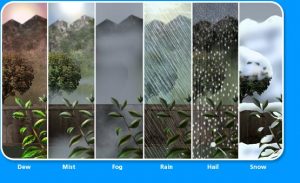
Different Types of Precipitation
Rain
Raindrops liquid from the clouds in the sky. It is described as water droplets of 0.3 mm or larger. Rain Droplets less than half a millimeter are defined as a drizzle. Raindrops frequently fall when small cloud particles bind together and strike, creating bigger raindrops. As this process continues, the raindrops get bigger and more to an extent where rain becomes too heavy to suspend in the air.
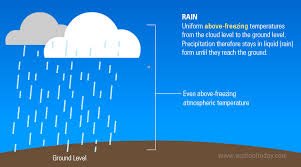
When high in the air, the raindrops start falling as snow or ice crystals but melt as rain proceeds down the earth through the warmer air. Rainfall rates differ from time to time, for example, the ranges of light rain from the rates of 0.01 to 0.1 inches per hour and moderate rain from rate 0.1 to 0.3 inches per hour and heavy rain rate above 0.3 inches per hour. Rain is the most common component of the replenishes and water cycle of most of the freshwater on the earth.
Sleet (Ice Pellets)
It takes place in freezing atmospheric conditions. Sleet, also called ice pellets, form, when the rain droplets fall into a freezing layer of air and snow, falls into a warm layer then melts into the rain that is cold enough to refreeze the raindrops into sleet. Hence, sleet is defined as a form of semitransparent balls of ice and precipitation composed of small. Sleet (ice pellets) should not be confused with hailstones as they are smaller in size.

It is often experienced during is normally accompanied by frosty ice crystals and thunderstorms that form white deposits and a mixture of slushy snow and semisolid rain. sleet bounce when they hit any other solid objects or hit the ground and fall with a hard striking sound.
Snow
They occur almost every time there is rain. However, it often melts before it reaches the earth’s surface. Snow is precipitation in the form of flakes or virga of ice water falling from the clouds. It is normally seen together with thin, weak, and high cirrus clouds. It can at times fall when the atmospheric temperatures are above freezing, but snow mostly occurs in sub-freezing air.
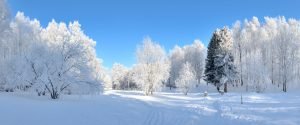
This evaporation leads to cooling just around the snowflake and makes snow reach the ground as snow. It has a white, fluffy, and soft structure and its formation is in different ways and shapes namely flat plates and thin needles. Each type of snow forms under specific combinations of atmospheric temperatures and humidity. The process is called snowfall.
Hail
This forms in cold storm clouds. hail forms when very cold water turns solid or droplets freeze, as soon as they touch things like dirt or dust. the upper part of the cloud The storm blows into the hailstones. Many frozen water droplets are added to the hailstone before it falls.
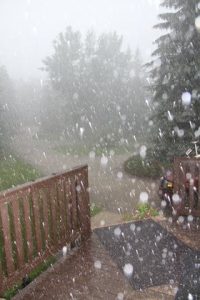
Unlike ice pellets, which is liquid when it freezes and forms as it falls to Earth, hail falls like a stone of solid ice.
Hailstones are usually the size of small stones, but hail can get as large as 6 inches (15 centimeters) across and weigh more than one pound.
Freezing Rain
It happens when rain falls during below temperatures and freezing conditions. Freezing rain normally results in the solidification of rain droplets. The raindrops are super-cooled while passing through the sub-freezing layer in the atmosphere and freezes by the time freezing rain reaches the ground. During freezing rains, it is common to witness an even coating of ice on streets, trees, cars, and power lines. It can build up to a thickness of several centimeters and The resulting coating of ice is called the glaze. Freezing rains pose a huge threat to normal operations of aircraft, power lines, and roadway transportation.
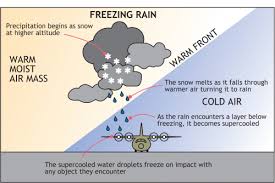
Sun Shower
It is a precipitation event that is registered when rain falls while the sun shines. Sun showers occur when the winds bearing rain together with rainstorms are blown several kilometers away, thus giving rise to raindrops into an area without clouds. Consequently, a sun shower is formed the sun’s rays penetrate through the raindrops, and when a single rain cloud passes above the earth’s surface.
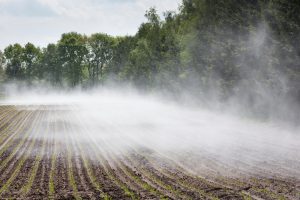
Drizzle
It is raining very lightly. Drizzle less than a shower but it is stronger than mist. Mist is a very thin fog with condensation near the ground earth. Fog is made up of cloud water or ice crystals droplets suspended at the earth’s surface or in the air near. It is droplets are smaller than (0.02 inches) 0.5 millimeters in diameter. drizzle arises from low stratocumulus clouds. drizzle sometimes evaporates even before reaching the ground due to their minute size.it can be persistent in cold atmospheric temperatures.
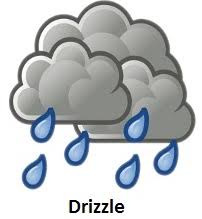
Snow Grains
Snow grains are opaque grains of ice and very small white. They are fairly flat and have a diameter generally less than 1mm. Snow grains are almost equivalent to the size of drizzle.

Diamond Dust
It is an extremely small ice crystal at temperatures below -30 °C and usually formed at low levels. It is got its name from the sparkling effect which is created when light reflects on the ice crystals in the air.

